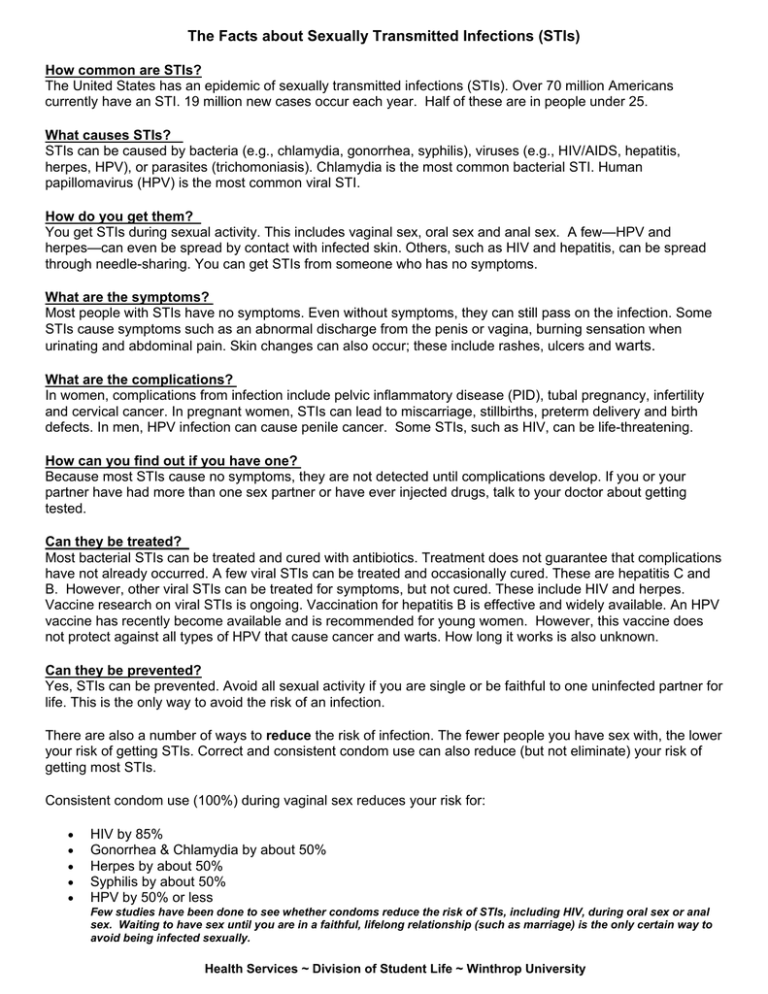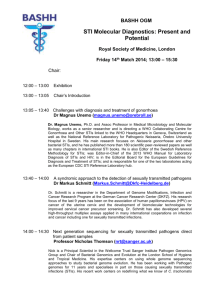The Facts about Sexually Transmitted Infections (STIs)
advertisement

The Facts about Sexually Transmitted Infections (STIs) How common are STIs? The United States has an epidemic of sexually transmitted infections (STIs). Over 70 million Americans currently have an STI. 19 million new cases occur each year. Half of these are in people under 25. What causes STIs? STIs can be caused by bacteria (e.g., chlamydia, gonorrhea, syphilis), viruses (e.g., HIV/AIDS, hepatitis, herpes, HPV), or parasites (trichomoniasis). Chlamydia is the most common bacterial STI. Human papillomavirus (HPV) is the most common viral STI. How do you get them? You get STIs during sexual activity. This includes vaginal sex, oral sex and anal sex. A few—HPV and herpes—can even be spread by contact with infected skin. Others, such as HIV and hepatitis, can be spread through needle-sharing. You can get STIs from someone who has no symptoms. What are the symptoms? Most people with STIs have no symptoms. Even without symptoms, they can still pass on the infection. Some STIs cause symptoms such as an abnormal discharge from the penis or vagina, burning sensation when urinating and abdominal pain. Skin changes can also occur; these include rashes, ulcers and warts. What are the complications? In women, complications from infection include pelvic inflammatory disease (PID), tubal pregnancy, infertility and cervical cancer. In pregnant women, STIs can lead to miscarriage, stillbirths, preterm delivery and birth defects. In men, HPV infection can cause penile cancer. Some STIs, such as HIV, can be life-threatening. How can you find out if you have one? Because most STIs cause no symptoms, they are not detected until complications develop. If you or your partner have had more than one sex partner or have ever injected drugs, talk to your doctor about getting tested. Can they be treated? Most bacterial STIs can be treated and cured with antibiotics. Treatment does not guarantee that complications have not already occurred. A few viral STIs can be treated and occasionally cured. These are hepatitis C and B. However, other viral STIs can be treated for symptoms, but not cured. These include HIV and herpes. Vaccine research on viral STIs is ongoing. Vaccination for hepatitis B is effective and widely available. An HPV vaccine has recently become available and is recommended for young women. However, this vaccine does not protect against all types of HPV that cause cancer and warts. How long it works is also unknown. Can they be prevented? Yes, STIs can be prevented. Avoid all sexual activity if you are single or be faithful to one uninfected partner for life. This is the only way to avoid the risk of an infection. There are also a number of ways to reduce the risk of infection. The fewer people you have sex with, the lower your risk of getting STIs. Correct and consistent condom use can also reduce (but not eliminate) your risk of getting most STIs. Consistent condom use (100%) during vaginal sex reduces your risk for: • • • • • HIV by 85% Gonorrhea & Chlamydia by about 50% Herpes by about 50% Syphilis by about 50% HPV by 50% or less Few studies have been done to see whether condoms reduce the risk of STIs, including HIV, during oral sex or anal sex. Waiting to have sex until you are in a faithful, lifelong relationship (such as marriage) is the only certain way to avoid being infected sexually. Health Services ~ Division of Student Life ~ Winthrop University






